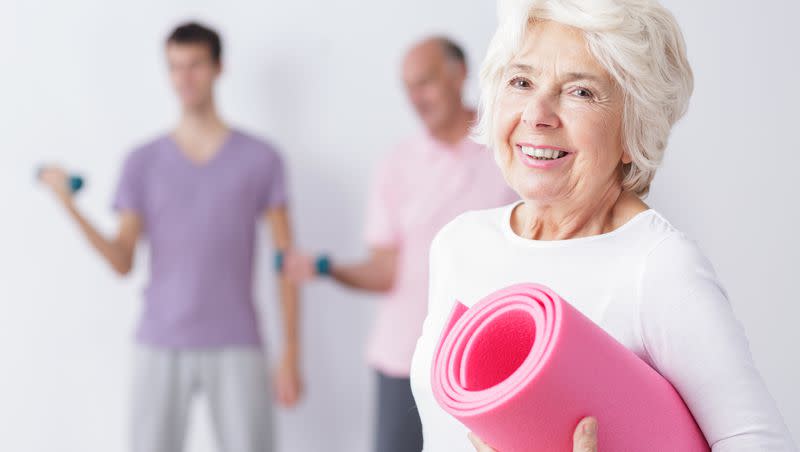You can reduce your chance of Alzheimer’s-caused death by doing vigorous exercise. Here’s how

Doing at least 20 minutes of vigorous physical activity, or VPA, a week may reduce one’s likelihood of developing Alzheimer’s disease later in life, per a study published this month by The Lancet, a medical journal on longevity.
Alzheimer’s disease is a chronic neurodegenerative disease that can become completely debilitating. Memory loss with Alzheimer’s sometimes becomes so severe that people forget the purpose of items they’ve used their whole lives — like forks and spoons, the Alzheimer’s Association explained.
The number of dementia cases in 2019 was 57.4 million globally, and a study published by Elsevier predicted this number would rise to 152.8 million in 2050.
This study tracked over 90,000 American adults with an average age of 75. It found that over half of the participants didn’t do any moderate physical activity, or MPA, throughout the week, and 80% didn’t do any VPA.
Those who reported higher MPA and VPA amounts had higher education levels, lower BMI and were likely younger, white males.
The study predicted that implementing 40 minutes a week of VPA “would prevent 12,238 deaths per year, and 140 weekly min of VPA would prevent 37,710 deaths per year,” compared with those who didn’t incorporate any VPA into their week.
Best vigorous exercises for seniors
1. Swimming/water aerobics: Swimming is one of the safest ways to get a full body workout. Since water supports 90% of one’s body weight, it’s the perfect way to exercise if arthritis makes it hard to do other activities, The Osborn explained. Water also reduces stress, anxiety and depression and facilitates better sleep.
Related
Should seniors exercise? The best exercise routine for seniors
Why elderly people should lift weights — new study shows encouraging benefits
2. Resistance bands: A study published by the journal Sports Medicine said, “Resistance training has been widely recommended as a strategy to enhance the functional autonomy and quality of life in older individuals.” Lit Method lists several resistance bands exercises and videos of how to do them here.
3. Walking: Better Health explained that walking strengthens bones and prevents osteoporosis. “Regular walking could halve the number of people over 45 who fracture their hip,” the health site added. If it’s too cold or icy to walk around your neighborhood, many people opt for walking around malls or indoor tracks.
4. Pickleball: This sport is easier on the joints than tennis and other racket sports, but many say it’s just as fun. Medical University of South Carolina Health said, “Racket sports boost the cardiovascular system which helps prevent many of the unwanted problems of older age like hypertension, stroke and heart attack. Pickleball gives you a good aerobic workout without as much stress and strain on joints and muscles, as mentioned above.”
Related
5. Dumbbell workouts: Dumbbell workout benefits include increased bone density, a stabilized body weight, improved balance, healthier joints and better body strength. Lifeline lists seven easy resistance band exercises with instructions and benefits here.
6. Cycling: A study published in Frontiers scientific journal explained the benefits of cycling for seniors. They wrote, “Scientific evidence shows that cycling can be an appropriate training to reduce the fear of falling, fat mass, high blood pressure, and cholesterol in older populations. It also leads to fitness benefits while improving the overall quality of life.”
7. Wall pushups: The American College of Sports Medicine set these pushup rates as guidelines for how many an individual should be able to do, Healthy Aging reported.
Men (50-59): Between 10 and 12 pushups.
Men (60+): Between eight and 10 pushups.
Women (50-59): Between seven and 10 pushups.
Women (60+): Between five and 11 pushups.
If you can’t do traditional pushups yet, MoreLifeHealth lists several ways to work up to it, including wall pushups, bench pushups and knee pushups.
What exercises should seniors avoid?
1. Squats with weight: This type of exercise places too much strain on the knees and can worsen arthritis.
2. Long-distance running: Propel Physiotherapy explains, “Older runners have a decreased ability to absorb the ground reaction forces associated with running resulting in injury. These injuries can include Achilles tendinopathy, plantar fasciitis, iliotibial band strain and shin splints.” Brisk walking or a light jog is recommended for seniors over long-distance running.
3. Rock climbing: Though rock climbing has lots of health benefits when done with the correct form, it has an increased risk of injury compared to other activities. However, if you’re interested in learning how to rock climb, there are quite a few older rock climbers who shared their experience doing it safely here.
4. Abdominal crunches: Marty Boehm, a physical therapist with Harvard-affiliated Brigham and Women’s Hospital, described the potential negative impacts of crunches for seniors. He said, “They’re dangerous because you’re pulling on your neck. And they don’t train your core. They train the hip flexor muscles. If those muscles get too strong, they pull on the lower back and contribute to back pain.”
5. Bench press: This exercise “involves repeatedly squeezing the chest muscles,” and many seniors already have issues with their chest muscles being too tight, senior fitness trainer Alexandra Smith told Silver Sneakers. If seniors want to do this exercise, it’s better to do it with free weights, or a machine using lighter weight.

